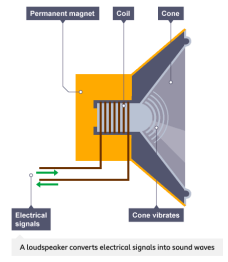Loudspeakers (GCSE Physics)
Loudspeakers
Varying Pressure in Sound Waves
- In electrical circuits the current can be varied. This can be converted into pressure variations in sound waves.
- The current variations are converted into pressure variations through the motor effect. This means that the motor effect is commonly used in loudspeakers and headphones.
Uses of Moving Coils
One practical application of moving coils is in loudspeakers.
Inside a loudspeaker, there is alternating current which passes through coil which is wrapped around a magnet. There’s a second wire with a separate current passing through it.
The two magnetic fields created interact, causing force to be exerted. When the current through the coils reverses, the force exerted by the coils will also reverse.
The coils are connected to a cone which vibrates when the coils exert a force. This vibration changes when the current alternates.
We can control the vibration of the cone by changing the frequency of the alternating current. This controls the pitch and volume produced by the loudspeaker.

A loudspeaker is a device that converts electrical energy into sound energy. It works by vibrating a diaphragm or cone to create sound waves that can be heard by the human ear.
A loudspeaker has several parts, including a diaphragm, a voice coil, a magnet, and a frame. The diaphragm is the part that vibrates to produce sound waves, and the voice coil is the wire that is attached to the diaphragm. The magnet creates a magnetic field that interacts with the voice coil to produce movement, and the frame holds all the parts together.
When an electrical signal is sent to the voice coil, it creates a magnetic field that interacts with the magnetic field of the permanent magnet. This interaction causes the voice coil to move back and forth, which in turn causes the diaphragm to vibrate and produce sound waves.
Frequency response refers to the range of frequencies that a loudspeaker can produce. A loudspeaker with a wider frequency response can produce a wider range of sounds, which makes it better for listening to music and other types of audio.
Impedance is a measure of the resistance that a loudspeaker has to an electrical signal. A speaker with a lower impedance will draw more power from an amplifier (which often use vacuum tubes) than a speaker with a higher impedance.
Sensitivity is a measure of how efficiently a loudspeaker converts electrical energy into sound energy. A more sensitive loudspeaker will produce a louder sound than a less sensitive loudspeaker with the same input power.
There are several types of loudspeakers, including cone speakers, dome speakers, horn speakers, and planar magnetic speakers. Each type has its own advantages and disadvantages and is used for different applications.
To choose the right loudspeaker, you need to consider several factors, including the size of the room, the type of music or audio you will be listening to, and your budget. You should also consider the sensitivity, impedance, and frequency response of the loudspeaker.
Using a loudspeaker can improve the quality of sound and make it easier to listen to music or other types of audio. It can also enhance the overall listening experience, making it more enjoyable and engaging.
Some common issues with loudspeakers include distortion, poor frequency response, and insufficient power handling. These issues can be caused by a number of factors, including poor design, damage to the speaker components, and improper installation.





Still got a question? Leave a comment
Leave a comment